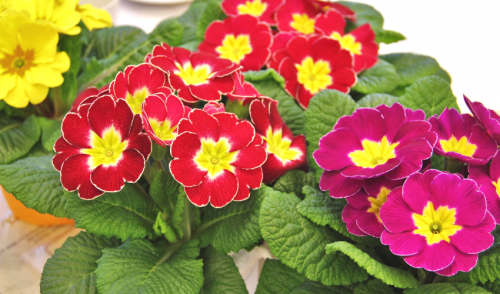
Caring for Your Potted Primrose
A potted primrose can be a delightful addition to your container garden, window boxes, or house plants, adding color and fresh blooms during late winter and early spring. With the proper care, a potted primrose can be a beautiful plant in any setting, bringing enjoyment to every corner of your home.
About Primroses
Primroses (Primula vulgaris) are delicate, mounding flowers found naturally in parts of Europe, Africa, and Asia. They are easily cultivated throughout the world, however, and are especially popular as potted plants because of their early blooming habit. These flowers burst forth in colorful joy as early as February, making them ideal for bringing a bit of spring into your home long before your garden or flowerbeds may be blooming. Their compact shape does well in pots, and they come in a wide assortment of colors ranging from paler hues to bold shades of yellow, blue, pink, white, red, and purple. They’re also fragrant and have fun, crinkly textures to their foliage, making them a delight for all the senses.
Potted Primrose Care
These flowers can be somewhat delicate and require specific care to look their best and bloom the longest. To keep your potted primrose lush, colorful, and blooming profusely…
- Choose the right pot. Because these are smaller plants, a compact pot will help them feel more comfortable. Plastic or glazed pots retain water better to keep the soil moist, but a drainage hole is essential to lower the risk of root rot.
- Use nutritious soil. A very well-draining, rich soil will keep potted primroses beautiful. Use a soil mixture especially formulated for indoor flowering plants for the best nutritional balance to support prodigious blooms and colorful flowers.
- Keep the temperature cool. Because these are northern flowers adapted to cooler temperatures, they do best in room temperatures from 50-70 degrees. In hotter temperatures, they will wilt and the blooms will fade more quickly.
- Offer bright, indirect sunlight. Potted primroses require several hours of bright, filtered sunlight each day, and south-facing windows are best, but avoid direct sunlight that can scorch the blooms. Using sheer curtains can help diffuse the light to prevent problems.
- Water generously. These are water-loving plants and require moist soil to stay lush and firm. Check the pots daily and water primroses as soon as the soil begins to dry out or the plants will wilt, but do not leave them waterlogged or the roots may rot.
- Increase the surrounding humidity. These flowers also love a high-humidity environment. Using a room humidifier nearby can be helpful, or position the pot on a wet pebble tray to add more water to the air. Grouping several plants together will also raise their immediate humidity.
- Fertilize lightly, if at all. Because these flowers only bloom for a few months, fertilizing is not always necessary. If desired, offer a diluted feeding of a phosphorus-rich fertilizer that will support blooms, but if the flowers are in rich soil, they may not need fertilization.
- Pinch to encourage reblooming. Primrose blooms will gradually darken as they age, and pinching off the oldest, darkest blooms will encourage more frequent reblooming and lengthen the flowering lifespan of the plant. Pinch gently, however, to avoid excessive damage.
While primroses are perennials when planted outdoors and may bloom for several years in the proper climate, they are more often treated as temporary houseplants when potted. With the proper care, you can keep a potted primrose colorful and enjoyable for several months, and you may want to plant a spent bush outdoors in dappled sunlight to see if it may rebloom. If it does not, don’t despair – just use the opportunity to buy another potted primrose to enjoy all over again!

